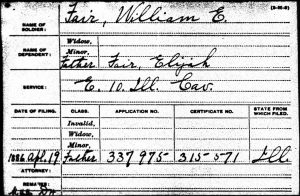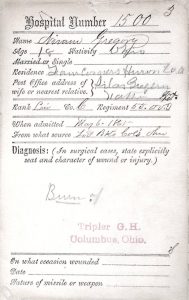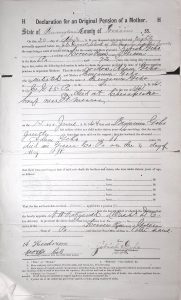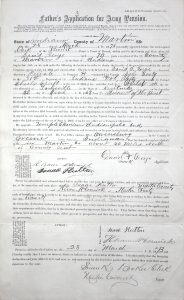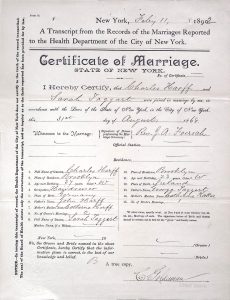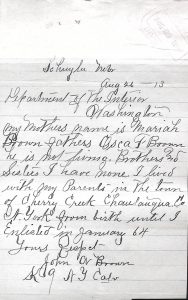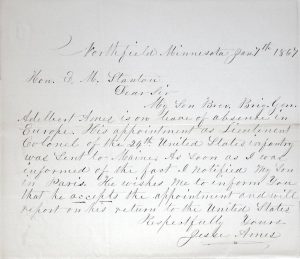We’re often asked whether a soldier’s Civil War records will include information about his parents. The answer is maybe! There are a variety of contexts in which his parents might be found in his records. Here are a few examples:
Example 1: Parental consent to enlist: The law required that a volunteer for service in the Civil War who was under the age of 18 must provide permission from a parent to enlist. A soldier’s service record will often include a copy of his enlistment record and on the back of that document is a section entitled “Consent in Case of Minor”. When completed, that section will typically contain the name and signature of at least one parent.
In actual practice, a recruit was not required to provide any evidence of his age. If he could pass for being 18 years old, then many recruiters were disinclined to ask questions. It was very common, in fact, for recruits to be 17 years old, 16, or even younger. Written evidence of parental consent is therefore pretty rare.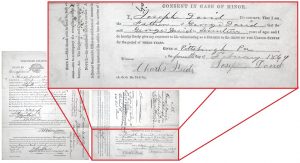
The soldier’s service record sometimes includes a bed card which is a record that was made when a soldier was admitted to a hospital. The bed card includes some demographic information, details about his admission, his diagnosis … and his nearest relative.
In the case of an unmarried soldier, this will sometimes include the name of a parent.
Example 3: The pension index card for the soldier’s parent(s): U.S. soldiers were paid for their service by the government and many soldiers would send that money home to support his family. If a soldier was killed in service (or died later due to a wound or disease that was acquired in service), then any direct family member who could prove that he/she was dependent on the money from the soldier to survive could apply for his pension benefits.
Eligibility for benefits was not limited to widows and minor children. If the soldier’s mother was destitute without the soldier’s support, then she could apply for her son’s pension benefits. Similarly, the soldier’s father could apply if he had no other means of support.
In addition to the mother’s name, Maria, notice that this pension index card indicates that she applied in 1889 (which is likely to have been shortly after the son died) and that she was living in Tennessee at the time of her application.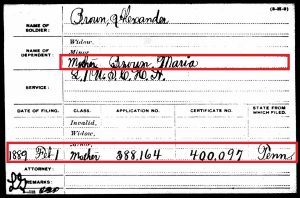
This index card for a different soldier identifies his father, Abram, who applied in 1892 while living in Michigan. 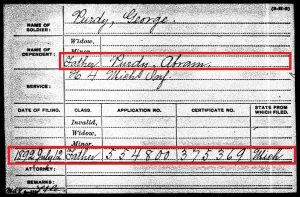
Only one person at a time can receive benefits based on a soldier’s service. The following index card identifies the soldier’s mother and father because they both received pension benefits – but not at the same time.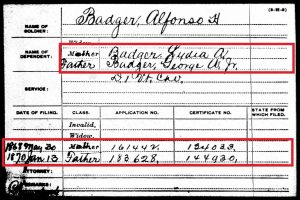
Note that in this example, the name of the parents can be determined from the index cards alone which can be found on Ancestry.com ($) or FamilySearch.org (free).
The remainder of this post refers to documents that may only be found within the pension file itself. That file must be obtained from the National Archives.
Example 4: Parent application
The pension file in each of these cases should include the parent’s application which typically includes at least the parent’s name, age, and city of residence. And while the parent’s pension index card may only identify the one parent, the application by that parent will typically identify the other parent and his/her status, i.e., dead, missing, disabled, etc.
Father’s application
Example 5: Marriage Certificate
When a widow applied for pension benefits, she was required to prove (among other things) that she was married to the veteran. That might be accomplished through a testimonial by the minister or a witness to the wedding. If you are fortunate enough to find a marriage certificate in the file, you’ll often learn the names of the veteran’s parents AND those of the wife’s parents. As an added bonus, the mothers’ maiden names offer a clue to yet another generation!
Example 6: Death Certificate
When a soldier died in service, the army did not provide a death certificate. Many cities and counties also didn’t provide death certificates until the early 1900s. So it ia always a wonderful surprise to find a death certificate in a pension file. In some cases, they even contain the birth place of the soldier’s parents.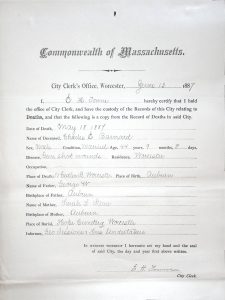
Example 7: Soldier’s letters
Under some circumstances, even the soldier’s sister could qualify for his pension benefits if she could prove that she had been financially dependent on him. One common way to show such evidence is to provide a letter that had been sent home by the soldier containing money and instructions about how to spend or distribute it. Such letters also commonly send greetings to other family members who are identified by name in the letter or on the envelope. This letter, for instance, is addressed to Ransom S. Estes and begins with “Dear father.”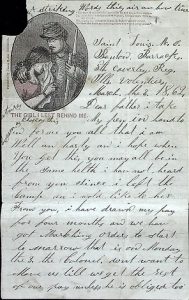
This letter from a soldier is written to the Pension Office (then part of the Department of the Interior) in answer to their request for his residential history. In it, he identifies both of his parents by name.
This letter was found in a “book mark” file associated with the soldier’s service record. In it, the soldier’s father writes on behalf of his son (who was unavailable) to the Secretary of War in order to accept the son’s appointment as Lt. Colonel.
More Examples:
The preceding are just a few examples of the wide variety of documents that might be found among a soldier’s military records that identify his parent(s). Others might include letters and testimonials by neighbors and friends, requests for reimbursement of funeral expenses, and the record of the soldier’s final accrued pension payment, among many other possibilities.
PRO TIP: If you are trying to identify a soldier’s parents, be sure to check the records of his brothers who were known to have served in the war. In fact, check the records of any soldier with the same last name who served in his company and regiment.
For instance, James E. Fair served in Co. E, 11th Illinois Cavalry. He lived until 1921 and his pension file does not identify his parents: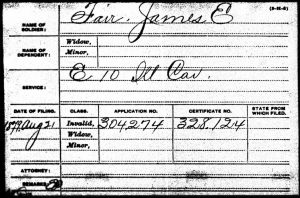
But his little brother, William, served in the same company and died during the war. Their father applied for benefits based on William’s service and was identified as Elijah Fair.